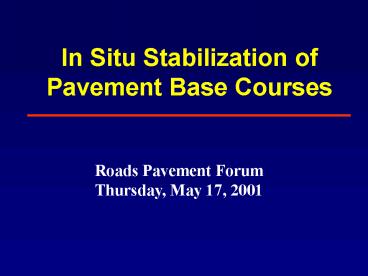In Situ Stabilization of Pavement Base Courses - PowerPoint PPT Presentation
1 / 30
Title:
In Situ Stabilization of Pavement Base Courses
Description:
UCS, ITS, Flexural Beam Test. Treated materials only ... Flexural beam test. Flexibility only increases at higher binder content. Elastic stiffness (Mr) ... – PowerPoint PPT presentation
Number of Views:229
Avg rating:3.0/5.0
Title: In Situ Stabilization of Pavement Base Courses
1
In Situ Stabilization of Pavement Base Courses
Roads Pavement Forum Thursday, May 17, 2001
2
Introduction
- Clients
- Gautrans
- CCI
- SANRAL
- Laboratory and Heavy Vehicle Simulator results
from R243/1 - One building block in a long-term process
- Focus on mechanical properties and structural
bearing capacity
3
Layout of presentation
- Purpose of the study
- Materials
- Experimental plan
- Results for each laboratory test
- Conclusions
4
Purpose
- Assess the benefits of in situ stabilization in
terms of improvements in the mechanical
properties and structural bearing capacity of the
treated material - Mechanical properties
- Resilient modulus
- Compressive and tensile strength
- Flexibility
- Shear strength
- Bearing capacity
- Effective fatigue
- Permanent deformation
5
Materials
- Basic material
- Ferricrete milled from HVS test site, including
existing surfacing and upper portion of subbase - Treatment processes
- Cement (Laboratory)
- 2 cement
- Foam and cement (Laboratory and HVS)
- 2 cement, 1.8 residual binder
- Emulsion and cement (Laboratory and HVS)
- 2 cement, 1.8 residual binder
6
Materials Untreated
- Nominal maximum aggregate size 37.5 mm
7
Materials Untreated
- Classification
- Grading G4
- Atterberg limits G5
- CBR G7
8
UCS, ITS, Flexural Beam Test
- Treated materials only
- Foam and emulsion tested at 2 binder contents
- 1.8 residual binder content 2 cement
- 3.0 residual binder content 2 cement
9
Flexural beam test
- Strain at crack initiation
- Indication of flexibility
10
Triaxial Tests
- Untreated and treated materials
- 1.8 residual binder content, 2 cement
- Variables
- Density
- Saturation
- Confining pressure
- Stress ratio
11
Triaxial tests
- Static triaxial tests
- Shear strength parameters
- Dynamic triaxial tests
- Resilient modulus
- Permanent deformation response
12
Compressive strengthUCS Results
- Cement-treated ferricrete has highest UCS
- Addition of binder reduces the UCS
13
Tensile strengthITS Results
- Cement-treated ferricrete has highest ITS
- Addition of binder reduces the ITS
14
Tensile strengthITS Results
- Samples dried to equilibrium MC at ambient temp
- 72 h in oven at 40º C
15
FlexibilityFlexural beam test
- Flexibility only increases at higher binder
content
16
Elastic stiffness (Mr)Dynamic triaxial tests
- Estimation of stiffness values
- Use regression model for untreated ferricrete
- Use ranges for treated materials
17
Comparative resultsAverage strain-at-break
18
Comparative results Effective fatigue life
- SAMDM transfer functions
- Working strain of 125 ??
- ?bvalues from flexural beam test
19
Comparative resultsCohesion
20
Comparative resultsFriction angle
21
Comparative resultsShear strength at ?3 50 kPa
22
Comparative resultsBearing capacity (9 PD)
23
HVS testsPavement structure
- 30 mm Asphalt
- 250 mm FTG / ETG
- - 1,8 residual
- bitumen
- - 2 cement
- In situ material
- In situ subgrade
24
HVS testsMaterials
25
HVS testsProgramme
- 2 x 100 m long experimental sections
- Foam-treated
- Emulsion-treated
- 1st Phase of HVS testing
- 80/100 kN tests (350 000/150 000 repetitions)
- Completed
- 2nd Phase of HVS testing
- 40 kN tests (750 00000 repetitions)
- In process
26
HVS testsDeflection result
27
ConclusionsUCS, ITS and Flexibility
- Complex relationship between UCS, ITS and
- Percentage binder
- Cementation
- Curing procedure
- Flexibility
- No increase in flexibility at low binder content
- Increase in flexibility and effective fatigue
life at higher binder content - Strain-at-break slightly higher for
foam-treatment at higher binder content - Effective fatigue life models to be validated
with HVS results
28
ConclusionsResilient modulus
- Increase in resilient modulus with treatment
- Untreated ferricrete
- Resilient modulus influenced by
- Relative density and saturation
- Stress state
- Treated ferricrete
- Resilient modulus dictated by the stabilizing
agent and largely insensitive to the above
parameters - No significant difference between stabilizing
agents - Resilient modulus values to be validated by HVS
back-calculation results
29
ConclusionsShear strength and plastic strain
- Shear strength increases with treatment
- Vastly improved bearing capacity in terms of
permanent deformation - Cement-treatment shows highest benefit
- No significant difference between foam- and
emulsion-treatment - Models need to be calibrated with HVS results
30
ConclusionsGeneral
- Only considered mechanical properties
- Other properties to investigate
- Permeability and erodibility
- Workability
- Shrinkage cracking
- Time to opening the road early strength
- Improved understanding of mechanical properties
and behaviour - Properties of stabilized material significantly
different from untreated material even at low
binder content - First structural design models for these types of
materials































